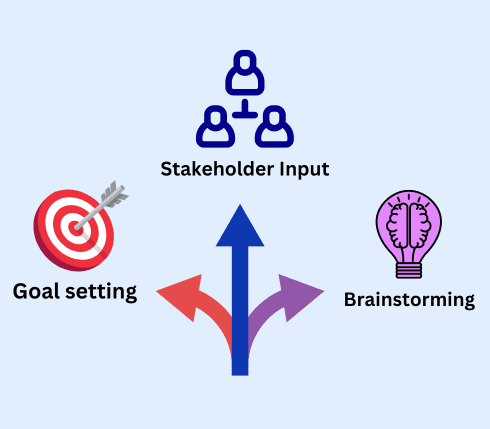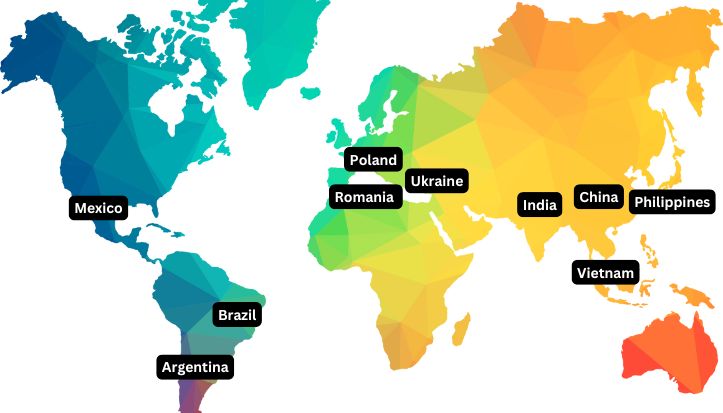In today’s rapidly evolving technological landscape, hiring dedicated developers has become a critical component for companies seeking to stay competitive. India continues to be a top destination for businesses worldwide, offering a vast pool of talented developers with a range of expertise. As of 2024, India boasts over 4.5 million software developers, a number that has been growing steadily. This success is driven in large part by the robust network of IT outsourcing companies in India. These companies provide businesses with access to experienced developers, reliable infrastructure, and cost-effective solutions tailored to meet diverse project needs. With a robust IT infrastructure and a steady stream of highly skilled graduates, India provides a rich talent pool for companies looking to hire remote developers.
This comprehensive guide aims to teach you how to hire remote developers effectively from India in 2024. By the end of this blog, you’ll understand the benefits, processes, and best practices to find and hire the best remote developers for your needs. Whether you’re a startup or an established enterprise, whether you are a CTO, Project Manager, or IT Director, this guide provides actionable insights and practical steps to ensure a successful hiring process.
Why Hire Remote Developers from India?
Here’s a breakdown of some key advantages of hiring remote developers from India, focusing on cost-effectiveness, talent pool, infrastructure, time zone benefits, and quality of work.
1. Cost-Effectiveness
- Competitive Pricing: Hiring developers from India is significantly more cost-effective compared to developers in North America or Europe. Even among Asian countries India remains at the top matching the service levels of the countries with higher rates.
- Detailed Cost Comparisons: Even among Asian countries India remains at the top matching the service levels of the countries with higher rates.
| Country | Average Hourly Rate (USD) |
| India | $18 – $25 |
| Indonesia | $21 – $24 |
| China | $20 – $25 |
| Bangladesh | $20 – $25 |
| Nepal | $22 – $25 |
| Philippines | $22 – $25 |
| Malaysia | $25 – $30 |
2. Talent Pool
- Diverse Skill Set: Indian developers possess a wide range of technical skills, from web and mobile app development to emerging technologies like AI, ML, blockchain, and IoT. In particular, AI companies in India have made significant strides in artificial intelligence, offering solutions that drive automation, data-driven decision-making, and innovative applications across industries
- High Level of Expertise: Many Indian developers have advanced degrees and professional certifications, ensuring they are well-equipped to handle complex projects. As per Mint, over 75% of MNCs prefer India for outsourcing.
3. Favorable Infrastructure
- Large Pool of English-Speaking Tech Professionals: India is home to a vast number of English-speaking developers, which facilitates seamless communication and collaboration with international clients.
- Robust Educational Infrastructure: With a strong emphasis on STEM education, India produces a significant number of highly skilled graduates every year, ensuring a steady supply of talented developers. Moreover, developers from tech hubs like Mumbai, Pune, Bangalore, and Hyderabad possess well-rounded skills, thanks to the diverse and dynamic work environments in these cities.
4. Time Zone Advantage
- Continuous Development Cycles: Round-the-clock productivity due to time differences.
- Faster Turnaround Times: Projects can progress continuously, reducing overall development time.
5. Quality of Work
- Testimonials and Case Studies: Numerous clients have reported high satisfaction levels with the quality of work delivered by Indian developers. For instance, Softlabs Group has completed over 5000 projects with clients across 25 countries, consistently receiving positive feedback for their high standards and professionalism.
- Proven Track Record: Case studies often highlight how Indian developers have successfully delivered complex projects on time and within budget, demonstrating their reliability and expertise.
By leveraging these strengths, companies can effectively tap into India’s vast pool of talented developers to drive their business forward.
Curating Project Roadmap
A clear understanding of your needs is essential to ensure your project’s success. The three most important factors to navigate your way ahead are:

1. Goal Setting: What Do You Want to Achieve?
- Define Objectives: Clearly state what you want to achieve, like increasing sales or improving user experience.
- Set Success Metrics: Decide how you will measure success, such as sales growth or user engagement rates.
- Align with Business Goals: Ensure your project goals match your overall business objectives.
2. Stakeholder Input: Who’s Involved?
- Identify Stakeholders: Know who is involved in the project, including team members and clients.
- Understand Their Needs: Learn what each stakeholder needs and expects from the project.
- Maintain Communication: Regularly update stakeholders on progress and changes to keep everyone aligned.
3. Brainstorming: What Hurdles Might You Face?
- Identify Challenges: Think about problems that could arise during the project.
- Develop Solutions: Plan how to address these challenges if they happen.
- Encourage Team Ideas: Work with your team to find creative solutions and strategies.
Where to Look for Dedicated Developers?
Once you are clear on the project requirements, it’s time to look for tech talent. Here are the top three avenues to explore:
1. Outsourcing Companies
Outsourcing companies are a reliable choice when looking to hire dedicated developers, especially from India. Reputable IT outsourcing companies like Softlabs Group, specialize in providing highly skilled Indian developers experienced in various technologies and industries.
Softlabs Group: With over 20 years of experience and a presence in the USA, UK, Sweden, and India, Softlabs Group has completed over 5000 projects for clients in more than 25 countries. Their developers are known for their expertise, professionalism, and ability to deliver high-quality work within deadlines. Partnering with a reputable outsourcing company like Softlabs Group ensures you get dedicated developers who understand your project needs and can seamlessly integrate with your team.
2. Platforms
Various online platforms offer a wide range of remote developers to choose from. These platforms provide access to a global talent pool but often come with challenges such as variable quality and commitment levels.
- Upwork: A popular platform where you can find freelance developers. However, the quality can vary widely, and you may need to sift through many profiles to find a suitable candidate.
- Toptal: Known for its rigorous screening process, Toptal offers top-tier developers. While the quality is high, the cost to hire a software developer can also significantly higher than other platforms.
- LinkedIn: A great tool for networking and finding developers, but it can be time-consuming to filter through profiles and ensure the candidates meet your requirements.
Another effective approach is partnering with leading software development companies in India. These firms not only provide access to skilled developers but also ensure quality assurance, project management, and adherence to international standards
3. Freelance Networks
Freelance networks and tech communities can be another avenue to explore when looking to hire software developers. These networks often consist of highly skilled professionals who prefer freelance work over full-time employment.
- Freelancer.com: Another platform similar to Upwork, but with the same issues of variable quality and commitment.
- GitHub: A community where developers showcase their work. It can be a good place to find developers with specific skill sets, but it requires more effort to assess their reliability and availability.
- Stack Overflow Talent: A platform where you can find developers who are active in the tech community. However, like GitHub, it requires effort to evaluate the candidates thoroughly.
By exploring these avenues, you can find the right developers who meet your project requirements and contribute to the success of your project.
Process of Hiring Remote Developers
Hiring the right developers is crucial for your project’s success. Here’s a step-by-step guide to help you through the process:
Step 1: Initial Screening
- Relevant Experience: Look for candidates with experience in the technologies and industry relevant to your project.
- Technical Skills: Ensure their skill set matches your project requirements. Look for specific technologies, frameworks, and tools.
- Project Examples: Check portfolios for completed projects similar to what you need. Look for detailed case studies or descriptions.
- Education and Certifications: Relevant degrees and certifications can be indicators of a candidate’s expertise and commitment to their field.
- Soft Skills: Communication, problem-solving abilities, and teamwork are crucial for remote collaboration.
Step 2: Technical Interviews
Sample Questions or Test Scenarios:
- Coding Challenges: Provide real-world coding problems related to your project. For example, if you need a web developer, ask them to build a small feature or fix a bug.
- Algorithm and Data Structure Questions: These questions assess a developer’s foundational knowledge. For instance, “How would you optimize a search function in a large dataset?”
- System Design Questions: For senior roles, ask them to design a system or architecture. Example: “Design a scalable e-commerce platform.”
- Technical Discussions: Have them explain their past projects, focusing on the challenges they faced and how they overcame them.
Step 3: Cultural Fit
Methods for Assessing Cultural Fit:
- Personality Tests: Tools like Myers-Briggs or DiSC can provide insights into a candidate’s working style and how they may fit in with your team.
- Trial Periods: Offer a short-term contract or a trial project to see how well they integrate with your team and work culture.
- Behavioural Interviews: Ask questions about their past work experiences to gauge their values and attitudes. Example: “Can you describe a time when you had to deal with a conflict within your team?”
Step 4: Negotiations
Strategies for Negotiating Rates and Terms Effectively:
- Market Research: Know the average rates for developers with similar skills and experience in your region and industry.
- Value Proposition: Highlight the benefits of working with your company, such as career growth opportunities, interesting projects, and work-life balance.
- Flexibility: Be open to negotiating terms beyond just salary, such as flexible working hours, remote work options, and additional benefits.
- Clear Terms: Ensure all terms are clearly defined in the contract, including payment schedules, project milestones, and deliverables.
Step 5: Swift Onboarding
Best Practices for a Smooth Onboarding Process:
- Documentation: Provide comprehensive onboarding documentation, including company policies, project details, and development guidelines.
- Tool Setup: Ensure the new hire has access to all necessary tools and platforms, such as version control systems, project management tools, and communication channels. Additionally staying up to date with recent IT trends will elevate your understanding of newer skill sets in demand.
- Orientation: Arrange an orientation session to introduce them to the team, explain the project’s goals, and clarify their role and responsibilities.
- Mentorship: Assign a mentor or buddy to help them settle in and address any questions or challenges they might face during the initial days.
By following these steps, you can streamline the process of hiring developers, ensuring you bring on board the right talent that fits both your technical needs and company culture.
Challenges to Overcome
This table provides an overview of common challenges and practical solutions to effectively manage a dedicated development team in India.
| Challenge | Solution |
| Time Zone Differences | Implement overlapping working hours and use project management tools to facilitate asynchronous work. |
| Commitment and Reliability | Start with a trial period or short-term contract to assess commitment and reliability. |
| Security Concerns | Use secure communication channels, sign NDAs, and implement robust data protection policies. |
| Legal and Contractual Issues | Consult with legal experts to draft clear contracts and understand local labour laws. |
| Project Management | Use project management tools (Trello, Jira) and adopt Agile methodologies to manage tasks and timelines. |
| Onboarding and Integration | Provide comprehensive onboarding materials and assign a mentor to help integrate new hires smoothly. |
| Retention and Motivation | Offer competitive compensation, recognize achievements, and provide opportunities for professional growth. |
| Different Work Ethics and Standards | Clearly define expectations, standards, and deadlines from the outset. |
| Maintaining Team Cohesion | Organize virtual team-building activities and encourage frequent informal interactions. |
| Tracking Progress and Accountability | Use time-tracking software and set clear, measurable goals and milestones. |
Conclusion
Hiring remote developers from India is highly beneficial. It offers cost savings, access to skilled talent, and leverages time zone differences for round-the-clock development. The future looks bright for the IT outsourcing industry. With remote work gaining popularity, advancements in collaboration tools and flexible work arrangements will boost productivity and efficiency. Remote hiring in India is set to grow, making it a smart choice for businesses worldwide.
Companies like Softlabs Group stand out as a premier choice for hiring remote developers from India as they possess:
- Global Presence: Offices in India, USA, Sweden, and UK.
- Technical Expertise: AI, Blockchain, IoT, and more, with .NET, Python, React, and Angular
- Flexible Models: Agile, Scrum, Lean, and Waterfall methodologies).
- Global Clientele: 2000+ clients in 25+ countries with a 90% client retention rate
- Industry Reach: Serves 20+ industries, including FinTech, Healthcare, Real Estate, and E-commerce.
- Portfolio: Case studies include AI-powered devices, IoT systems, REIT platforms, and ERP software.
- Positive Feedback: Known for dedication, flexibility, and clear communication
Connect with Softlabs Group now and start leveraging India’s best tech talent for your business needs!





